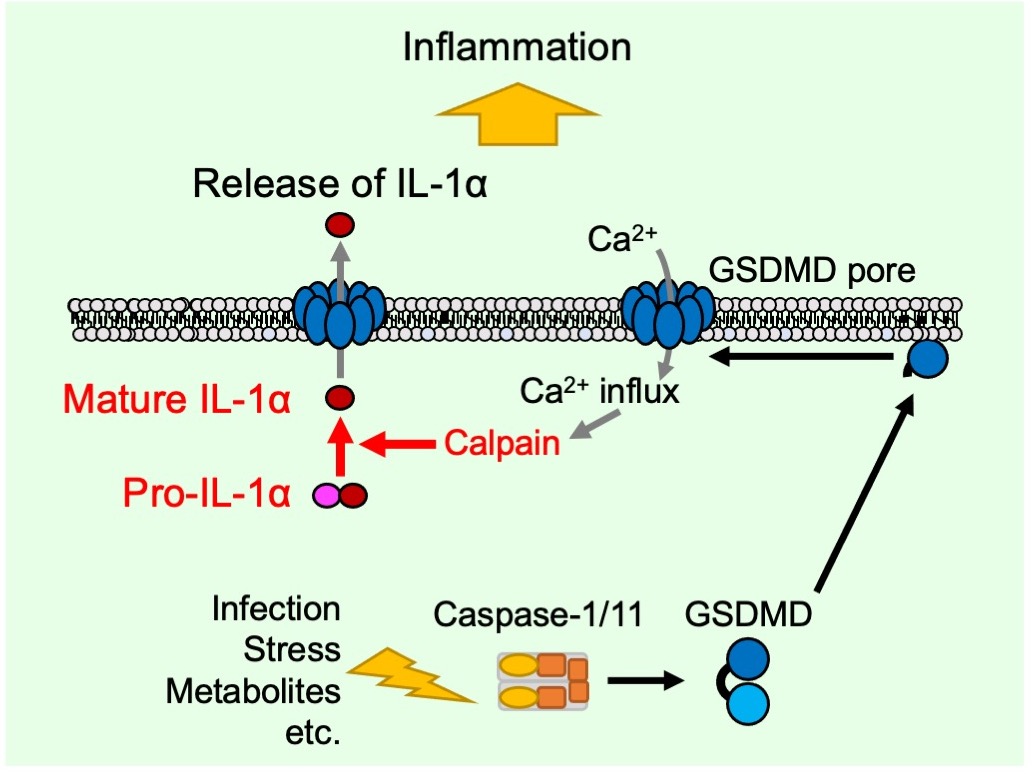Abstract:Researchers from Kanazawa University have found that gasdermin D, a protein known to be involved in cell death, is crucial for maturation and release of interleukin-1α, an important inflammatory mediator. When the inflammasome is activated, caspase-1 cleaves gasdermin D into two parts: one of these parts travels to the membrane, where it forms a pore that allows calcium influx and activation of calpains, promoting interleukin-1α activation and exit from cells.
Kanazawa, Japan – Interluekin-1α (IL-1α) is an important part of the immune response, but until now it has been unclear how this molecule is processed from its precursor, pro-IL-1α, and exits the cell during inflammasome activation. Now, researchers from Japan have found that gasdermin D, a protein that was already known to mediate pyroptosis, a form of regulated cell death, plays a crucial role in the maturation and release of IL-1α.
In a study published in March in Cell Reports, researchers from Kanazawa University report that, when the inflammasome (a part of the innate immune system) is activated, gasdermin D forms pores in the cell membrane that allow factors from outside of the cell to flow in, leading to the activation and release of mature IL-1α.
Previous work has shown that inflammasome activation leads to gasdermin D being cut in two by an enzyme, and that one half of the cut protein forms membrane pores. This leads to pyroptosis whereby the pores let water into the cells, causing them to swell and burst.
“We knew that caspase-1 cleaves gasdermin D, and that this enzyme is also important for IL-1α activation,” says lead author of the study Kohsuke Tsuchiya. “We therefore suspected that gasdermin D might be involved in the pathway leading to IL-1α release.”
To test this possibility, the researchers deleted the gene encoding gasdermin D, and found that this almost completely eliminated IL-1α exit from the cells. Unexpectedly, though, they also saw that virtually no mature IL-1α was present inside these cells.
“This made us think that gasdermin D is important not only for IL-1α release, but also IL-1α maturation,” explains Takashi Suda, lead author of the study. “When we looked into this in more detail, we found that gasdermin D did not need to cause cell lysis for these effects to take place. Instead, only its ability to form pores in the membrane was required for both IL-1α maturation and release.”
The researchers went on to show that pore formation by gasdermin D allows calcium influx and activation of calpains (a type of proteases), which promotes processing of the pro-IL-1α precursor into mature IL-1α maturation.
“Our findings provide the missing link between caspase-1 activity and IL-1α maturation,” says Tsuchiya.
Given that inflammasome activation is a key element of both inflammatory diseases and the response to infection, this study provides important insight into essential functions of the human immune system. Identifying gasdermin D as a regulator of immune function as well as cell death increases our understanding of how inflammasome activation ultimately leads to IL-1α release from immune cells.

Figure
Caspase-1, a protease of the caspase family, is activated in response to microbial infections, cellular stresses, and so on, through inflammasome activation, resulting in maturation of the key pro-inflammatory cytokines IL-1α and IL-1β. Although caspase-1 directly processes pro-IL-1β into the mature form, pro-IL-1α is not a substrate for caspase-1. It has long been unclear why activation of caspase-1 causes maturation of IL-1α. This study revealed that gasdermin D (GSDMD), an executor of cell death called pyroptosis, mediates IL-1α maturation downstream of caspase-1. Caspase-1 cleaves GSDMD, and its N-terminal fragment forms pores in the cell membrane. This allows the influx of calcium ions, leading to activation of calpains and processing of pro-IL-1α into its mature form by calpains. Maturation of IL-1 not only increases its activity but also facilitates its release from the cell through GSDMD pores. Therefore, GSDMD plays a critical role in caspase-1-dependent inflammatory events, which include the maturation and release of IL-1α. As GSDMD and IL-1α have been implicated in the pathogenesis of several inflammatory diseases, this signaling pathway may be a therapeutic target for such disorders.
[Funder]
This work was supported by a Grant-in-Aid for Scientific Research on Innovative Areas (KAKENHI grant no. 26110002) and a Grant-in-Aid for Scientific Research (B) (KAKENHI grant no. 20H03484) from the Japan Society for the Promotion of Science. This work was also supported by the Japan Society for the Promotion of Science (KAKENHI grant no. 18K07106), the Hokkoku Cancer Foundation, and the Takeda Science Foundation.
[Article]
Title:Gasdermin D mediates the maturation and release of IL-1α downstream of inflammasomes,
Journal:Cell Reports
Authors:Kohsuke Tsuchiya, Shoko Hosojima, Hideki Hara, Hiroko Kushiyama, Mamunur Rashid Mahib, Takeshi Kinoshita, Takashi Suda



 PAGE TOP
PAGE TOP